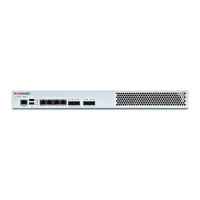System Configurations Diagnostic Tools
Click [Test] to start testing. And IP conflict message may be one of:
l Test completed, no IP conflict has been found.
l There is an IP conflict with a PC in DMZ, a public IP which has been assigned to WAN in [Network Settings] is now
used in DMZ, for example. And the MAC address of this IP is also listed in the message.
l There is an IP conflict with a PC in WAN; a public IP has been assigned to DMZ in [Network Settings] is now used in
WAN, for example. And the MAC address of this IP is also listed in the message.
Clean IPv4 Session Table (Only Non-TCP Sessions)
The function is used to clean up non-TCP session tables in FortiWAN. In FortiWAN, protocols are managed with a
session timer. Old sessions may be continuously retried by users that they keep unexpired. These old sessions, are
always being valid and active instead of new ones. Hence, new sessions will not get into use unless session tables are
cleaned up.
IPv4 Ping & Trace Route
Ping
[Ping] is used to detect network status. Enter an IP address or host name of target device. Select a port (WAN, LAN, or
DMZ). If WAN port is selected, specify the WAN link number index. Details of ICMP error message and ping are
outside the scope of this manual. Please refer to other documents for more information.
Note: If you ping a domain name, ensure DNS server have been specified in [System]->[Network Settings]->[DNS
Server] (See "Set DNS server for FortiWAN").
Trace
[Trace] is used to trace the route path of a packet from a specific port to destination host. Enter an IP address or host
name of target device in [Target]. Select a link port (WAN, LAN, or DMZ). If WAN port is selected, specify the WAN link
number index. [Host] can be an IP address or domain name of the target device.
Note: If you trace route with a domain name, ensure DNS server has been specified in [System]->[Network Settings]->
[DNS Server] (See "Set DNS server for FortiWAN").
Arping
[Arping] is used to detect the MAC address of a PC. Enter an IP address or host name of target device. Select a port
(WAN, LAN, or DMZ). If WAN port has been selected, specify the WAN link number index. Details of ARP and error
message are out of the scope of this manual; please refer to other documents for more information.
Note: If you arping with a domain name, ensure DNS server has been specified in [System]->[Network Settings]->
[DNS Server] (See "Set DNS server for FortiWAN").
IPv4 ARP Table Show & Clear
[IPv4 ARP Table Show & Clear] is used to display or clear the ARP information of certain port. Select a [port] and click
[Show], to display the ARP information of this port. Or select a [port], click [Clear] to clean up the ARP information of
this port, and confirm the message to clear. After this, a message shows that ARP table has been cleared successfully.
71 FortiWAN Handbook
Fortinet Technologies Inc.

